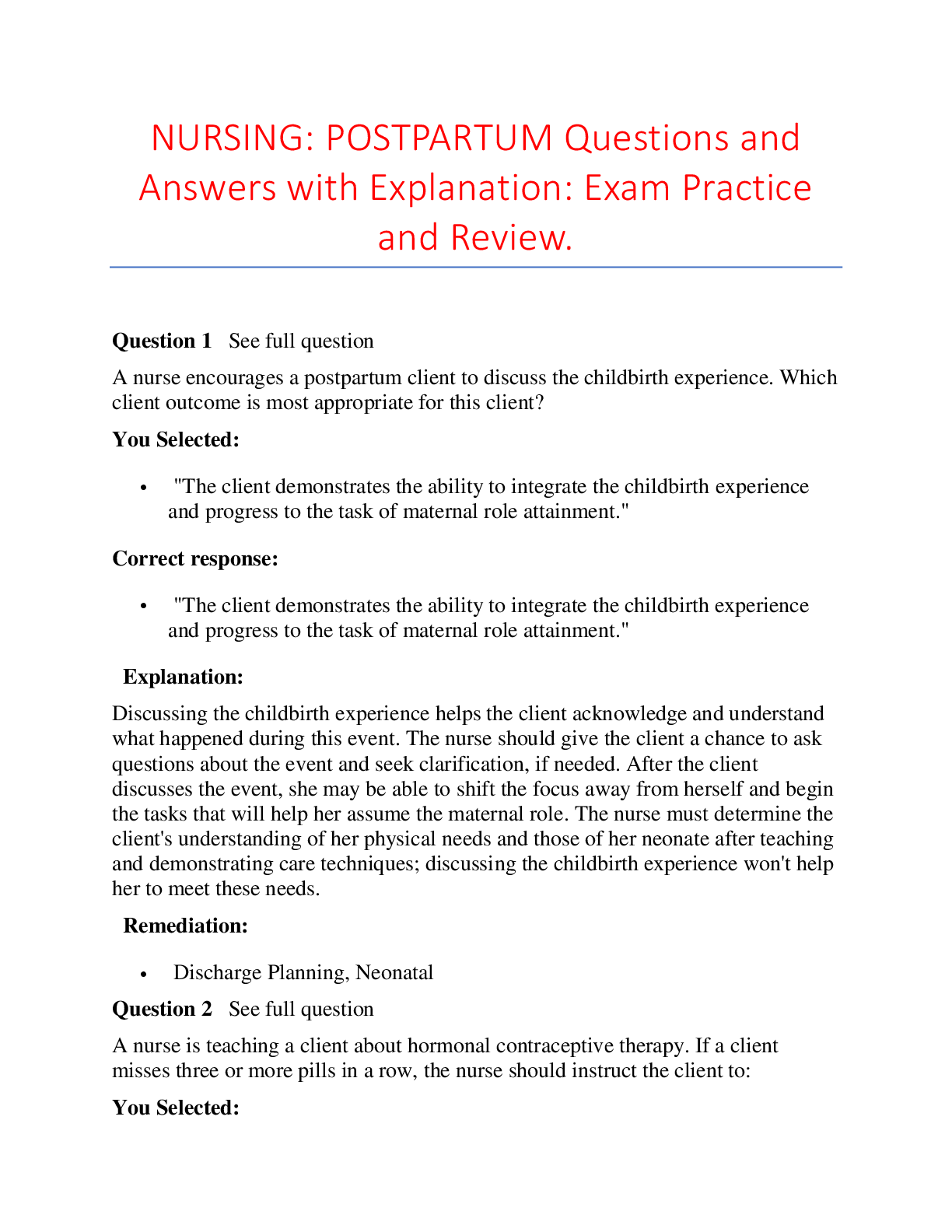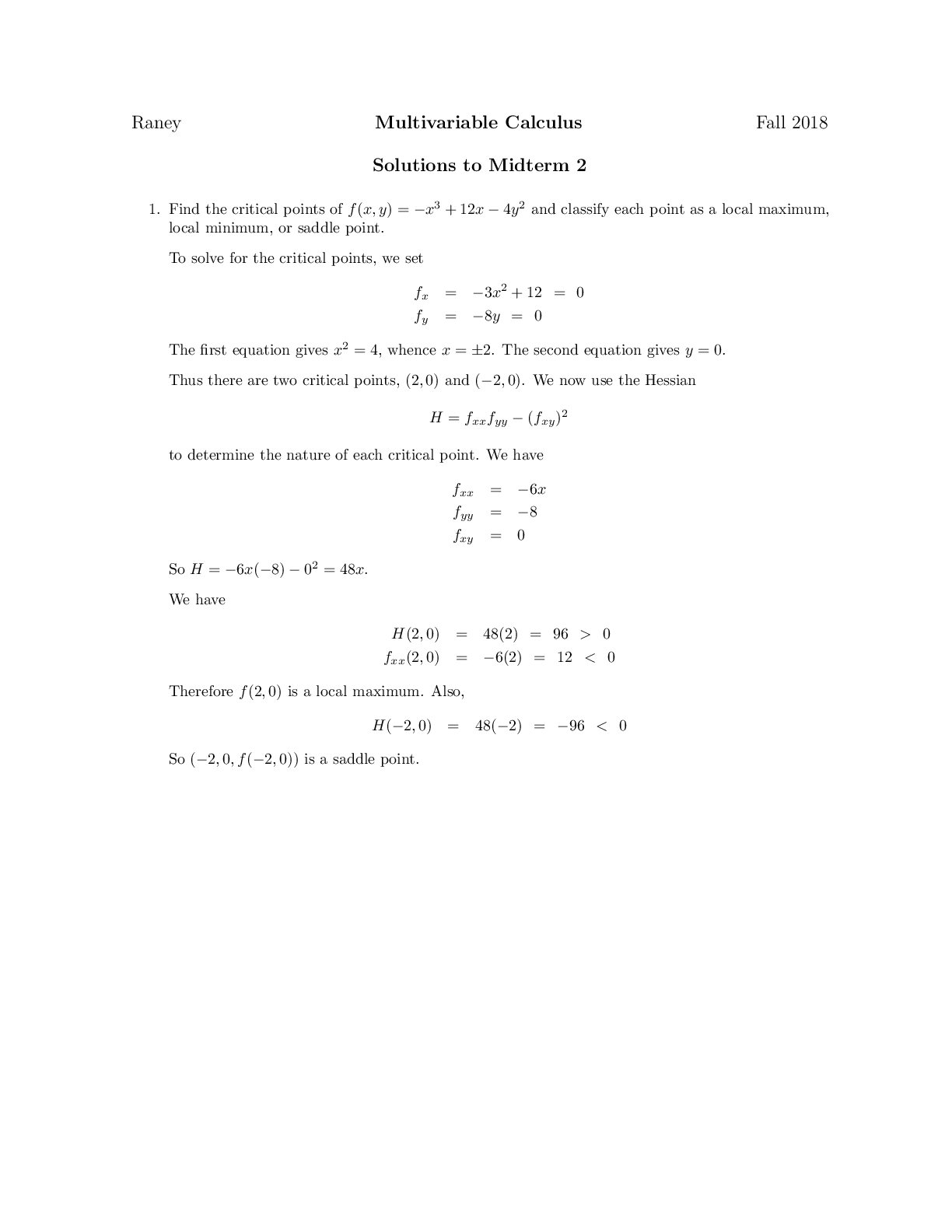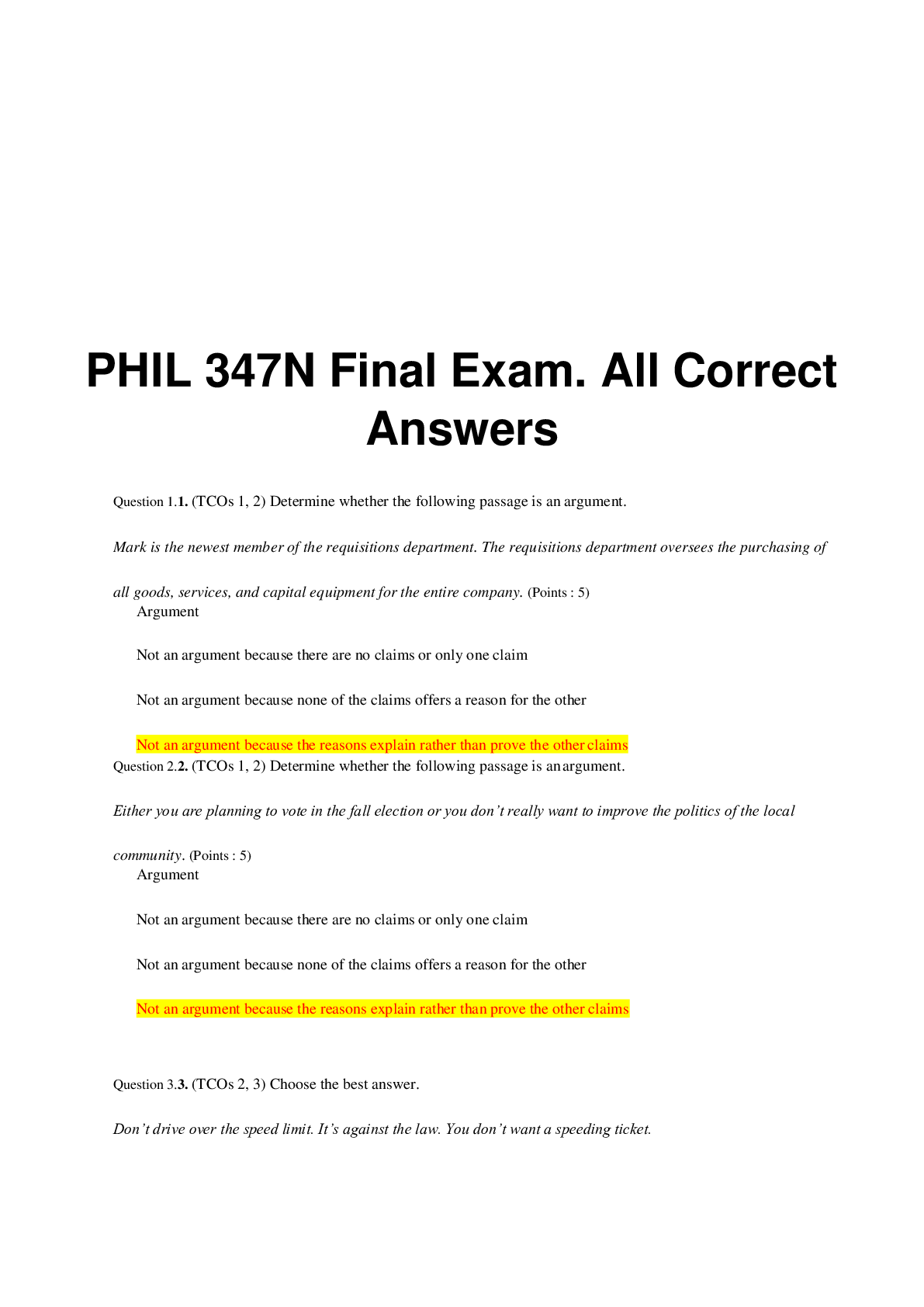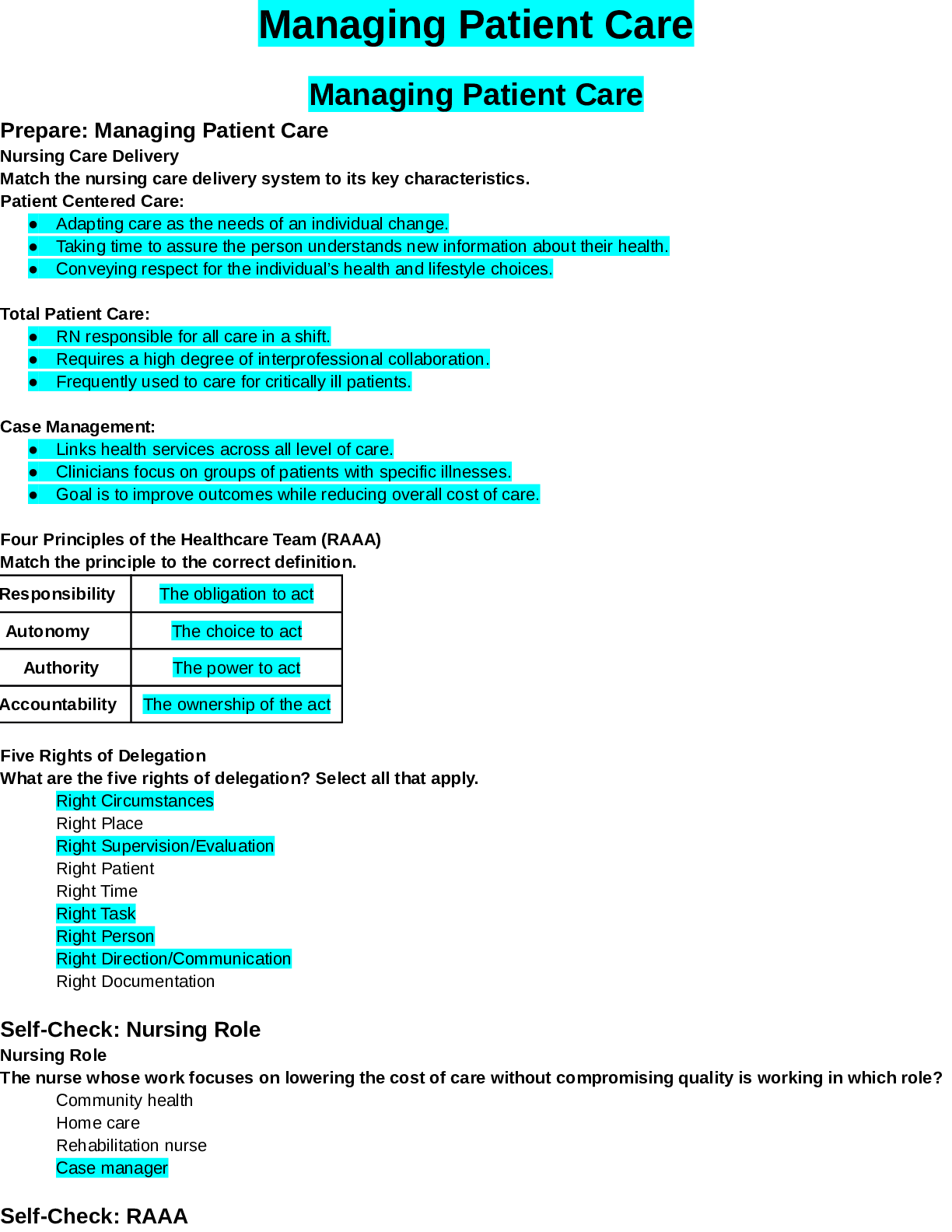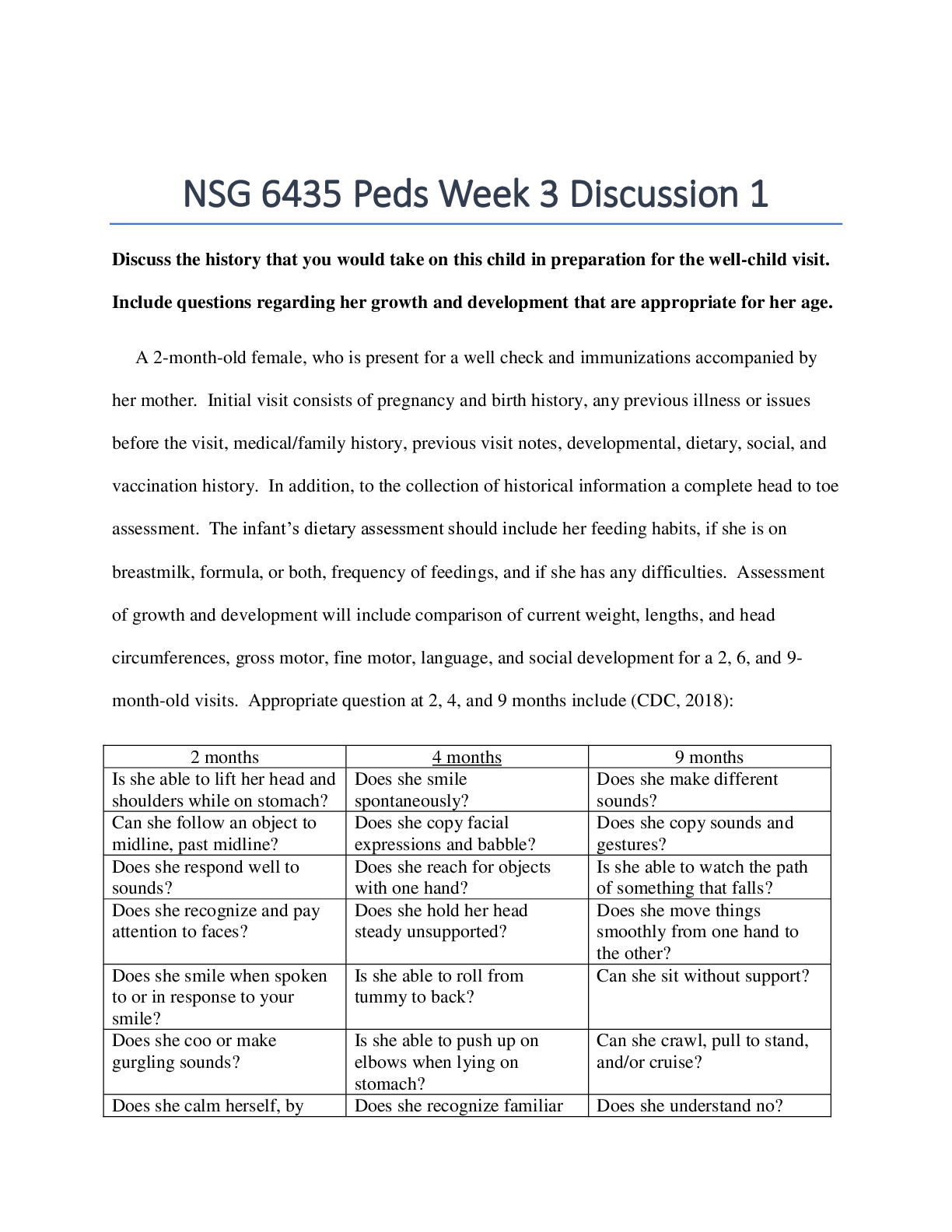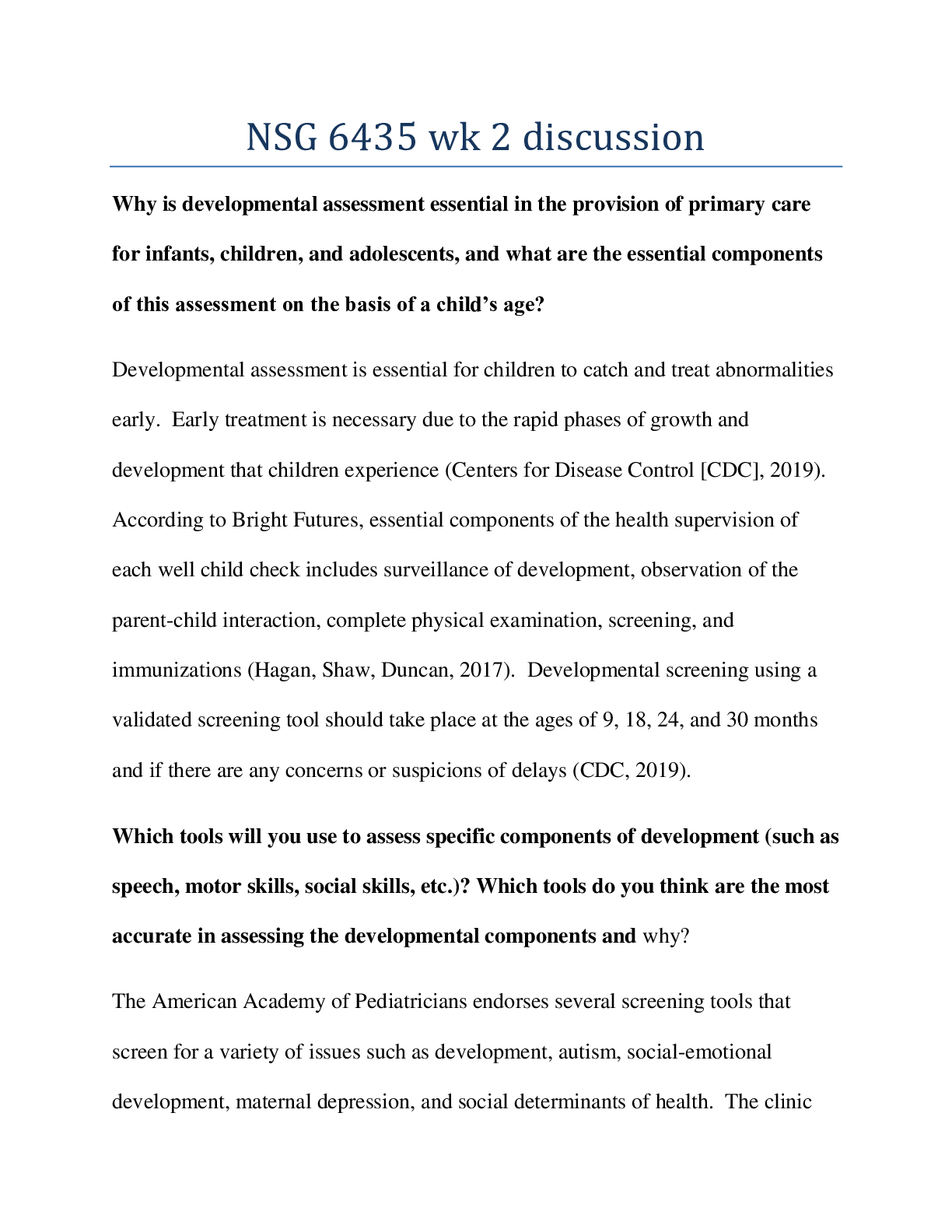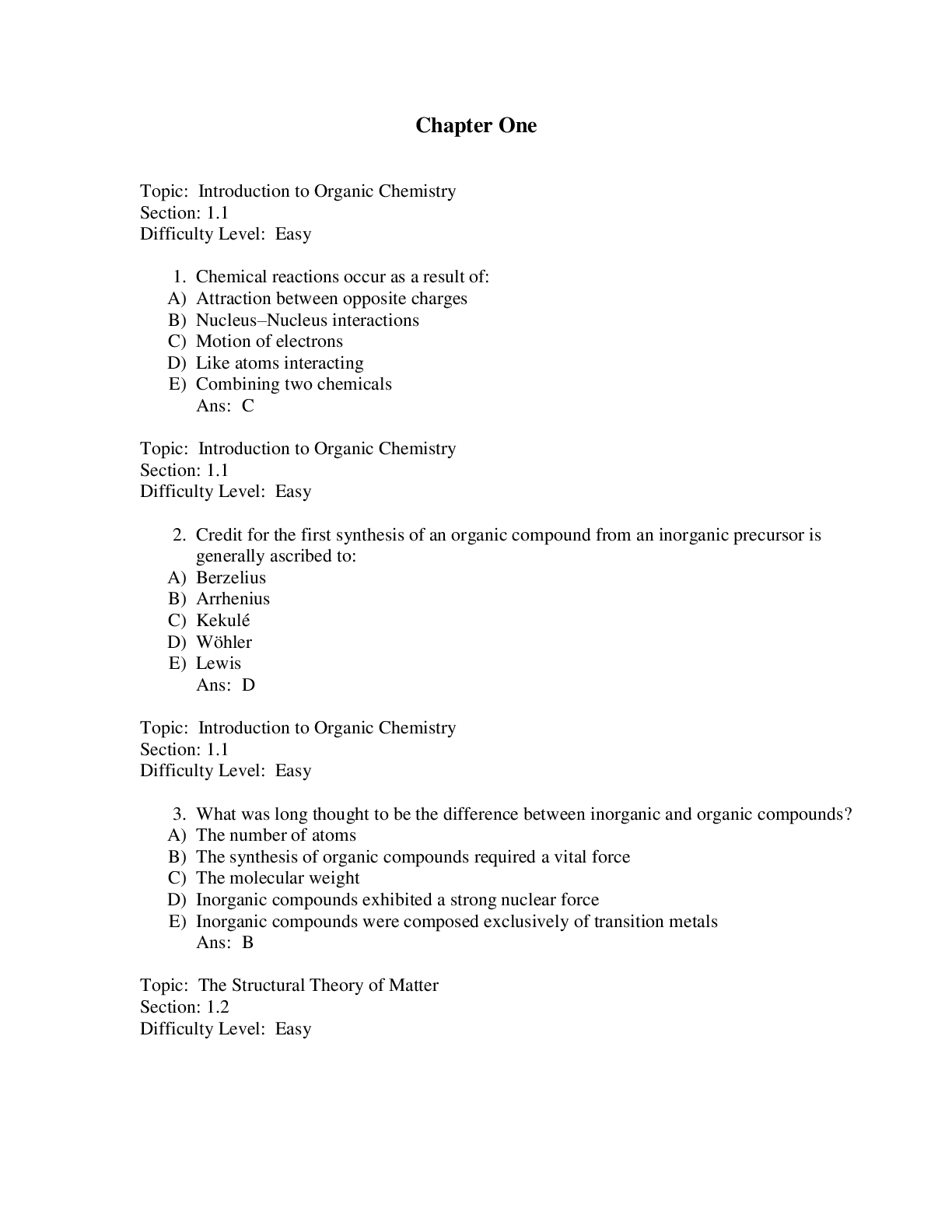Economics > QUESTIONS & ANSWERS > BSA 101/ ECONOMICS/ ANSWER KEY PRELIM EXAM. 65 Questions and Answers. 100%. (All)
BSA 101/ ECONOMICS/ ANSWER KEY PRELIM EXAM. 65 Questions and Answers. 100%.
Document Content and Description Below
ANSWER KEY PRELIM EXAM EXAM DATE: 9/16/2020 1. What is the legal basis of the COA in promulgating the GAM for NGAs? a. Revised Penal Code, Art. 217 b. State Audit Code of the Philippines, P.D. No.... 1445, Sec. 109 c. Article IX-D, Section 2 par. (2) of the 1987 Constitution of the Republic of the Philippines d. R.A. 9298 2. The GAM for NGAs aims to update all of the following except a. standards, policies, guidelines and procedures in accounting for government funds and property b. coding structure and accounts c. accounting books, registries, records, forms, reports and financial statements d. rules and regulations regarding the filing and payment of taxes by government employees 3. Which of the following is one of the Fundamental Principles for Revenue under the GAM for NGAs? a. No payment of any nature shall be received by a collecting officer without immediately issuing an official receipt in acknowledgement thereof. The receipt may be in the form of postage, internal revenue or documentary stamps and the like, officially numbered receipts, subject to proper custody, accountability, and audit. b. Temporary receipts may be issued to acknowledge the receipt of public funds; provided that, an official receipt is issued within a short period of time as may be prescribed by the COA. c. Money in the hands of the Collecting Officer may be utilized for the purpose of cashing private checks, upon proper endorsement and identification of the payee or endorsee. Checks drawn in favor of the government in payment of any such indebtedness shall likewise be accepted by the officer concerned. d. All of these 4. Which of the following is not one of the Fundamental Principles for Disbursement of Public Funds under the GAM for NGAs? a. No money shall be paid out of any public treasury or depository except in pursuance of an appropriation law or other specific statutory authority. b. Government funds or property shall be spent or used solely for public purposes. c. Trust funds shall be available and may be spent only for the specific purpose for which the trust was created or the funds received. d. Fiscal responsibility shall, to the greatest extent, be assumed solely by the Head of the government agency. 5. Which of the following statements is incorrect regarding the GAM for NGAs? a. The COA shall keep the general accounts of the Government and, for such period as may be provided by law, preserve the vouchers and other supporting papers pertaining thereto, pursuant to Section 2, par. (1), Article IX-D of the 1987 Philippine Constitution. b. The financial reporting system of the Philippine government consists of accounting system on accrual basis and budget reporting system on budget basis under the statutory responsibility of the NGAs, Bureau of the Treasury (BTr), Department of Budget and Management (DBM), and the COA. c. The objectives of general purpose financial statements (GPFSs) are to provide information about the financial position, financial performance, and cash flows of an entity that is useful to a wide range of users in making and evaluating decisions about the allocation of resources. Specifically, the objectives of general purpose financial reporting in the public sector are to provide information useful for decision-making, and to demonstrate the accountability of the entity for the resources entrusted to it. d. The DBM accounts for the cash, public debt and related transactions of the NG.6. This accounting concept is necessary so that users can use information in the financial statements in noting differences and similarities between those information presented and information from other sources that the user may have. a. Financial statement analysis and ratios b. Understandability c. Comparability d. Feedback value or confirmatory value 7. Which of the following principles is not in accordance with the Basic Government Accounting and Budget Reporting Principles under the GAM for NGAs? a. modified accrual basis of accounting in accordance with the PPSAS b. budget basis for presentation of budget information in the financial statements (FSs) in accordance with PPSAS 24 c. RCA prescribed by COA d. financial statements based on both accounting and budgetary records e. fund cluster accounting 8. The NGAs are responsible for a. promulgating accounting and auditing rules and regulations. b. implementing the national budget with the goal of attaining the nation’s socio-economic objectives. c. receiving and keeping national funds and managing and controlling the disbursements thereof. d. directly implementing the projects of, and performing the functions delegated by, the government. 9. The basis of accounting required by the GAM for NGAs is a. Budget basis b. Modified accrual basis c. Cash basis d. Accrual basis 10. The President’s explanation of the country’s fiscal policy and budget priorities is contained in a document called the a. National Expenditure Program b. President’s Budget Message c. President’s Fiscal Policy and Priorities d. Budget of Expenditures and Sources of Financing 11. After the incurrence of obligations, the next step in the budget cycle is a. Allotment b. Disbursement c. Appropriation d. Disbursement authority 12. It is the expenditure authority derived from appropriation laws, government ordinances, and other decisions related to the anticipated revenue or receipts for the budgetary period. a. Notice of Cash Allocation b. Allotment c. Approved Budget d. General Appropriations Bill 13. After the budget call, budget hearings are made whereby agencies defend their proposed programs and expenditures for the upcoming year before the a. COA b. DBM c. Congress d. BTr 14. Under responsibility accounting, a cost is considered controllable at a given level of managerial responsibility if a. the manager has the power to incur it within a given period of time. b. the cost is non-recurring, can be measured with sufficient reliability and is not immaterial c. the cost is a fixed cost, such that its incurrence is reasonably certain. d. all of these.15. Which of the following statements best differentiates the government accounting process from the accounting process of a business entity? a. The government accounting process involves numerous complicated steps or procedures that are beyond the understanding of a mere JPIA member, but not for a CPA. b. The government accounting process involves procedures that are not generally acceptable for business entities. c. The government accounting process is similar to that of a business entity, except that it incorporates budgetary controls, such as recording in the budget registries and preparing periodic budget accountability reports. d. Unlike for the accounting process of business entities which ends in the preparation of general purpose financial statements, the government accounting process ends with the audit by the COA. 16. This report, required of government entities, shows the names of creditors, the amounts owed to them, and the number of days these obligations are outstanding. This report is submitted to the COA and DBM within 30 days after the end of the year. a. List of Not Yet Due and Demandable Obligations b. Aging of Due and Demandable Obligations c. Percentage of Obligations Report d. Report on Allotments, Obligations and Disbursements 17. Under this approach to budgeting, several parties participate in the budget preparation, starting from the lowest levels of the government up to the highest levels. a. Bottoms-up budgeting b. Zero-based budgeting c. Incremental budgeting d. Bottom-up budgeting 18. It encompasses the processes of analyzing, recording, classifying, summarizing and communicating all transactions involving the receipt and disposition of government funds and property, and interpreting the results thereof. a. Government accounting b. Government reporting c. Government auditing d. Tax accounting 19. The GAM for NGAs is promulgated by the a. Commission on Accounting (COA) b. Commission on Audit (COA) c. Board of Accountancy (BOA) d. Bureau of Internal Revenue (BIR) 20. The Commission on Audit (COA) is responsible for a. the formulation and implementation of the national budget with the goal of attaining the nation’s socio-economic objectives. b. receiving and keeping national funds and managing and controlling the disbursements thereof. c. directly implementing the projects of the government. d. promulgating accounting and auditing rules and regulations. 21. Which of the following is not charged with government accounting responsibility? a. Commission on Audit b. Bureau of Internal Revenue c. Non-stock, non-profit private hospital d. Department of Budget and Management22. Which of the following qualitative characteristics may be sacrificed when reporting information on a timely basis? a. Relevance b. Reliability c. Substance over form d. Faithful representation 23. According to the GAM for NGAs, information has this qualitative characteristic if it can be used to assist in evaluating past, present or future events or in confirming or correcting past evaluations. a. Feedback value b. Predictive value c. Materiality d. Relevance 24. This refers to the comparability between the financial statements of different entities? a. Inter-comparability b. Intra-comparability c. Horizontal comparability d. Vertical comparability 25. When the substance of a transaction or event differs from its legal form, the entity should report the transaction’s or event’s a. substance b. legal form c. a trade-off between a and b d. either a or b, based on their significance 26. The implication that users must be informed of the entity’s policies, changes to those policies, and the effects of those changes refers to a. Comparability b. Completeness c. Understandability d. Reliability 27. In the financial reporting system of the national government, to which of the following shall an entity reconciles its cash records? a. Commission on Audit b. Bureau of Treasury c. Department of Budget and Management d. Office of the President 28. Which of the following approaches to budget preparation provides the best internal control? a. Incremental budgeting b. Zero-sum budgeting c. Top-down budgeting d. Zero-based budgeting 29. This approach to budgeting requires the justification of items in the budget irrespective of whether they are new or carried over from the previous year. a. Zero-based budgeting b. Bottoms-up budgeting c. Incremental budgeting d. Bottoms-down budgeting30. Which of the following is correct regarding zero-based budgeting? a. Several parties participate in the budget preparation starting from the lowest levels of the government to the highest levels. b. All zeroes in the budget are omitted. c. All proposed programs and expenditures in the upcoming year must be new. Programs and expenditures in the previous year should never be carried over to the next year. d. The current year’s budget is formulated without regard to the previous year’s budget. 31. Which of the following would most likely comes first in the budget process? a. Budget accountability report b. President’s enactment of the budget c. Presentation to the Office of the President d. Budget Call from the DBM 32. Which of the following would most likely comes last in the budget process? a. Budget accountability reports b. Allotment c. Disbursements d. Performance review 33. Entity A, a government entity, receives authorization to disburse funds not to exceed ₱1B in a specified period. This event can be described as a. Notice of Cash Allocation b. Allotment c. Appropriation d. Adontknowcation 34. Entity A, a government entity, receives notice that out of its ₱10B approved budget for the year, Entity A can incur obligations up to ₱4B in the first quarter. This event can be described as a. Notice of Cash Allocation b. Allotment c. Appropriation d. Amnotsurecation 35. Entity A, a government entity, receives notice that for the current year, the maximum amount it can spend on maintenance and other operating expenses is ₱10B. This event can be described as a. Notice of Cash Allocation b. Allotment c. Appropriation d. Budgetication 36. After receiving its obligational authority amounting to ₱4B, Entity A enters into binding agreements for the eventual payments of a total sum of ₱3B. The “₱3B” event can be described as a. Disbursement b. Allotment c. Disbursement authority d. Obligation 37. It is a part, segment, unit or function of a government agency, headed by a manager, who is accountable for a specified set of activities. a. Responsibility Accountingb. Responsibility Center c. Budget Center d. Call Center 38. Guil College, a private not-for-profit college, received the following cash inflows: • $400,000 from students for tuition. • $200,000 from a donor who stipulated that the money be invested indefinitely and the earnings used for student scholarships. • $100,000 from a donor who stipulated that the money be spent according to the wishes of the Board of Trustees. Which amounts of these cash flows should be shown on the cash flow statement as cash from operating activities? a. $700,000. b. $400,000. c. $600,000. d. $500,000. 400,000 tuition + 100,000 unrestricted = 500,000 39. On December 30, 19X4, Leigh Museum, a not-for-profit organization, received a $7,000,000 donation of Day Co. shares with donor stipulated requirements as follows: • Shares valued at $5,000,000 are to be sold with the proceeds used to erect a public viewing building. • Shares valued at $2,000,000 are to be retained with the dividends used to support current operations. Leigh adopted of FASB Statement No. 117, Financial Statements of Not-for-Profit Organizations. As a consequence of the receipt of the Day shares, how much should Leigh report as temporarily restricted net assets on its 19X4 statement of financial position? a. $0 b. $2,000,000 c. $5,000,000 d. $7,000,000 40. CIBA, a non-profit performing arts organization, received a contribution of a term endowment and a regular endowment. These endowments should be reported on the statement of activities as: a. Permanently restricted in Term Endowments; Permanently restricted in Regular Endowments b. Temporarily restricted in Term Endowments; Permanently restricted in Regular Endowments c. Temporarily restricted in Term Endowments; Temporarily restricted in Regular Endowments d. Unrestricted in Term Endowments; Temporarily restricted in Regular Endowments 41. Vista, a voluntary health and welfare organization, received a donation of $100,000 to be spent in accordance with the wishes of the institution’s Board of Trustees. This donation should be reported on the statement of activities as: a. Unrestricted revenue. b. Other income – gifts. c. Temporarily restricted revenue d. Permanently restricted revenues 42. Ellen College, a private not-for-profit institution, received a $100,000 grant for faculty research in 20x1. The grant money was not spent until 20x2. For 20x1, Ellen College should report the contribution as: a. Unrestricted revenue b. Temporarily restricted revenue. c. Other operating revenue. d. Other non-operating revenue.43. An NPO hospital has the following account balances: Amount charged to patients $500,000 Revenue from newsstand 15,000 Undesignated gifts 40,000 Contractual adjustments 70,000 Interest income 12,000 Salaries expense – nurses 120,000 Bad debts 8,000 What is the hospital’s net patient service revenue? a. $422,000 b. $430,000 c. $500,000 d. $540,000 (500,000 – 70,000) = 430,000 44. Home Care, Inc., a nongovernmental voluntary health and welfare organization, received two contributions in 2003. One contribution of $250,000 was restricted for use as general support in 2004. The other contribution of $200,000 carried no donor restrictions. What amount should Home Care report as temporarily restricted contributions in its 2003 statement of activities. a. $450,000 b. $250,000 c. $200,000 d. $0 45. The Weyman Hospital, a private, not-for-profit institution, reported the following information: Gross patient service revenue $1,000,000 Allowance for discounts to hospital employees 20,000 Bad debt expense 40,000 Contractual adjustments 100,000 What amount should the hospital report as net patient service revenue? a. 840,000 b. 900,000 c. 880,000 d. 980,000 46. A private not-for-profit hospital provided $150,000 in charity care for the current year. The hospital should report this charity care as a. Net patient service revenue of $150,000 and patient care expense of $150,000. b. Net patient service revenue of $150,000 on the statement of operations. c. Only in the notes to the financial statements. d. As an unpaid accounts receivable on the balance sheet. 47. The Johnson Hospital, a private not-for-profit hospital, received the following revenues in the current year: Proceeds from sales of the Hospital’s flower shop $60,000 Dividends and interest revenue not restricted $20,000 Cash contributions for the renovation of the children’s ward in the Hospital $200,000 Which of these amounts should be reported as other revenues and gains (other revenue) on the Statement of Operations? a. $280,000 b. $60,000 c. $80,000 d. $260,000 48. A hospital has the following account balances: Revenue from newsstand $ 50,000 Amounts charged to patients 800,000 Interest income 30,000Salary expense – nurses 100,000 Bad debts 10,000 Undesignated gifts 80,000 Contractual adjustments 110,000 What is the hospital’s net patient service revenue? a. $880,000 b. $800,000 c. $690,000 d. $680,000 49. A private not-for-profit performing arts center receives the following three donations: • A gift of $90,000 which is unrestricted. • A gift of $125,000 restricted for payment of salaries. • A gift of $200,000 that is restricted forever but the income from the gift may be used for current expenditures. Which of the following is not true? a. Temporarily restricted net assets increased by $125,000. b. Permanently restricted net assets increased by $325,000. c. When the money is spent for salaries, unrestricted net assets increase and decrease by the same amount. d. When the money is spent for salaries, temporarily restricted net assets decrease. 50. Cash flows from a public university bookstore would appear on the statement of cash flows as a. Cash flows from operations. b. Cash flows from investing activities. c. Cash flows from financing activities. d. Cash flows from noncapital financing 51. Which one of the following is not a required financial statement for a private voluntary health and welfare organization? a. Statement of Financial Position b. Statement of Activities and Changes in Net Assets c. Statement of Fund Balance d. Statement of Cash Flows e. Statement of Functional Expense 52. Gerlack College, a private, not-for-profit institution, received a donation of $2,000,000 as a challenge grant. If the college raises an additional $2,000,000 within the next two years, it may keep the donation. If it fails, the $2,000,000 must be returned to the donor. How would the college record the receipt of the grant? a. Unrestricted revenue. b. Temporarily restricted revenue. c. Note to the financial statement. d. Refundable advance. 53. Which of the following transactions of a private voluntary health and welfare organization would increase temporarily restricted net assets in the statement of activities for the current year? I. Received a contribution of $20,000 from a donor in the current year who stipulated that the money not be spent until the following year. II. Spent $25,000 for fund raising during the current year from a donation from the previous year. a. I only b. I & II c. II only d. Neither54. On December 31, 20X1, the Board of Trustees of a private, not-for-profit college designated $5,000,000 of unrestricted net assets for the construction of an addition to the music building. What effect does this designation have on the college’s unrestricted and temporarily restricted net assets shown on the statement of financial position on December 31, 20X1? a. Decrease in Unrestricted Net Assets; Increase in Temporarily restricted net assets b. Decrease in Unrestricted Net Assets; No effect in Temporarily restricted net assets c. No effect in Unrestricted Net Assets; Increase in Temporarily restricted net assets d. No effect in Unrestricted Net Assets; No effect in Temporarily restricted net assets 55. The following contributions were received by a private voluntary health and welfare organization. Which of these would not be recorded as an increase in unrestricted revenue? a. A carpenter donated labor and materials for the construction of a deck. b. A painter donated paint and labor to paint all the meeting rooms. c. A retired college professor donated reading services to senior citizens. The organization would not have paid for these services if they had not been donated. d. A CPA firm donated its services to audit the financial statements for the past year. 56. In November 20x1 Gilmore Heating and Air Conditioning Service repaired the air conditioning system for GenCare, a voluntary health and welfare organization and mailed an invoice for $3,000. On December 25, a note was received by GenCare indicating that Gilmore was canceling the invoice and that repairs were being donated. For the year ended, December 31, 20x1, GenCare should report these contributed services as: a. A footnote. b. No disclosure is required but a thank-you note was mailed to Gilmore. c. An increase in unrestricted revenues and an increase in expenses on the statement of activities. d. An increase in temporarily restricted net assets in the statement of activities. 57. Which of the following types of health care organizations recognize depreciation expense? Investor-Owned Not-for-Profit Organizations Governmental Health Care Health Care Enterprises Organizations a. Yes Yes No b. Yes No Yes c. No No Yes d. Yes Yes Yes 58. According to US GAAP, the accounting requirement unique to Voluntary Health and Welfare Organizations (VHWO) is the a. accounting for marketable securities which are subsequently measured at the lower of cost and market value. b. non-depreciation of property, plant and equipment. c. provision of a statement of functional expenses that reports expenses by both functional and natural classifications. d. recognition criteria for assets, which allow the recognition of items with improbable inflows of resources embodying economic benefits. 59. ABC Organization, a non-profit entity, acquired shares of stocks to be held as investment for ₱200,000 using unrestricted net assets. During the year, ABC received cash dividends of ₱10,000. At year-end, the shares have a fair value of ₱220,000. What is the effect of the transactions described above on the year-end statement of activities of ABC? increase (decrease) a. 30,000 b. 20,000 c. (10,000) d. 10,00060. Private not-for-profit organizations should report a statement of cash flows using the a. Direct method. b. Indirect method c. Working capital method d. a or b 61. On the statement of operations of a health care organization, expenses are deducted from (use SFAS 117 in answering this question) a. Temporarily unrestricted revenues. b. Unrestricted revenues. c. Unrestricted revenues and temporarily unrestricted revenues. d. Permanently restricted revenues. 62. On the statement of activities of a private university, expenses are reported by (use SFAS 117 in answering this question) a. Character b. Department c. Object d. Function 63. According to SFAS 117, the financial statements of a not-for-profit entity should focus on the a. Economic resources measurement approach. b. Current resources measurement approach. c. Basic information on the organization as a whole. d. Modified accrual approach. 64. On December 1, 20x1, ABC Organization, a non-profit entity, had the following transactions: • Purchased a vehicle costing ₱150,000 using unrestricted cash • Received a vehicle with fair value of ₱120,000 from donation ABC estimates that both of the vehicles have useful lives of 5 years and no residual value. ABC has an accounting policy implying a time restriction on gifts of long-lived assets. In ABC’s 20x1 statement of activities, what amount of depreciation expense should be included under changes in unrestricted net assets? a. 54,000 b. 4,500 c. 13,312 d. 0 [Show More]
Last updated: 2 years ago
Preview 1 out of 10 pages

Buy this document to get the full access instantly
Instant Download Access after purchase
Buy NowInstant download
We Accept:

Reviews( 0 )
$13.00
Can't find what you want? Try our AI powered Search
Document information
Connected school, study & course
About the document
Uploaded On
Feb 10, 2021
Number of pages
10
Written in
Additional information
This document has been written for:
Uploaded
Feb 10, 2021
Downloads
0
Views
159

